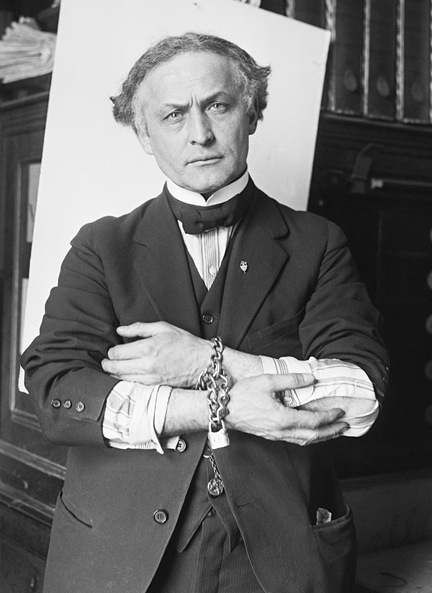On this date in 1874, Erik Weisz was born in Budapest, Hungary. His parents were Rabbi Mayer Weisz and Cecília Steiner. In 1878 the family emigrated to America and settled in Appleton, Wis., before relocating to New York City in 1887. He chose his stage name because he admired the French magician Jean Eugene Robert-Houdin. Houdini began his magic career in 1891, initially performing traditional magic tricks but later focusing almost exclusively on escape acts.
In 1894 he married his wife Bess, a fellow performer. Houdini toured Europe beginning in 1900 and became well-known for an act where police would restrain him in handcuffs which he would then escape. He toured America with variations of this act and other escape routines, including escaping from a straitjacket and the famous Chinese Water Torture Cell, where Houdini would escape from a water-filled cell where he was hanging by his ankles. He served as the president of the Society of American Magicians from 1917 until his death.
Although many magicians of the era claimed to have supernatural powers, Houdini never did. In the 1920s he began to focus on debunking psychics and mediums, using his training in magic to expose techniques that created the illusion of their so-called “supernatural” powers. He was part of a Scientific American committee that offered a cash prize for successful proof of supernatural abilities, a prize that was never awarded.
He made a pact with his wife, who was also his stage assistant that she was to make regular attempts to contact him after his death, including an annual séance on Halloween. If it was possible, he said he would convey to her a secret phrase they agreed upon to prove it was really him. He never made contact.
After 10 years, Bess bestowed the responsibility for the ritual to trusted magician friend Walter Gibson. The tradition has been passed down to other magicians who have preserved it to this day, with no contact with Houdini ever reported. James Randi carried on Houdini’s challenge, offering $1 million dollars to anyone who could demonstrate supernatural ability.
Houdini died in 1926 of peritonitis and appendicitis, aggravated by punches to the stomach. (Houdini famously was asked by J. Gordon Whitehead if he could sustain punches to the stomach; after Houdini’s affirmative response, Whitehead immediately punched the magician, who was not prepared for the blows.) He was buried in a Jewish cemetery in Queens, but his gravesite pays homage to his career in magic rather than his Jewish heritage; in fact, a bust of Houdini was placed at the grave in 1927, although a “graven image” was not allowed according to Jewish law. D. 1926.


